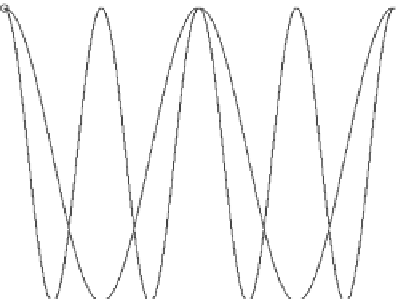Image Processing Reference
In-Depth Information
f
a
(
x
): Original analog signal
Reconstructed signal
= Signal samples
1
f
s
1
=
Δ
x =
300
x
Δ
x
2Δ
x
3Δ
x
4Δ
x
5Δ
x
6Δ
x
FIGURE 2.11
One-dimensional example of aliasing.
The signal has frequency components of 200 and 300 cycles per unit length in
the
x- and
y-directions, respectively. Thus the Nyquist rate for the signal
is
f
Nyquist
¼
(400, 600) cycles per unit length. To avoid aliasing,
the sampling rate must exceed the Nyquist rate. Now suppose we sample the
signal at a rate below the Nyquist frequency, say 300 and 400 samples per unit
length in the x- and y-directions, respectively. Then the sampled signal is
2
(200, 300)
¼
400
p
300
nþ
600
p
400
m
4
3
nþ
3
2
m
f (n, m)
¼
2 cos
¼
2 cos
4
3
n
3
2
m
2
3
n
2
m
¼
2 cos
2
pnþ
2
pm
¼
2 cos
2
3
nþ
2
m
¼
2 cos
Now, if we send the sampled signal through an ideal digital to analog converter
(D
=
A), the resulting continuous signal would be
2
3
300x þ
2
g(x, y)
¼
2 cos
400y
¼
2 cos (200
pxþ
200
py)
This means that the reconstructed signal appears as a low-frequency signal.
Example 2.3
To show aliasing in an image, we
first downsample the monochromic LENA image
shown in Figure 2.12a by a factor of 4 and then upsample it to the original size
without using any anti-aliasing
filter. The resulting image is aliased as shown in
Figure 2.12b.





















































































































Search WWH ::

Custom Search